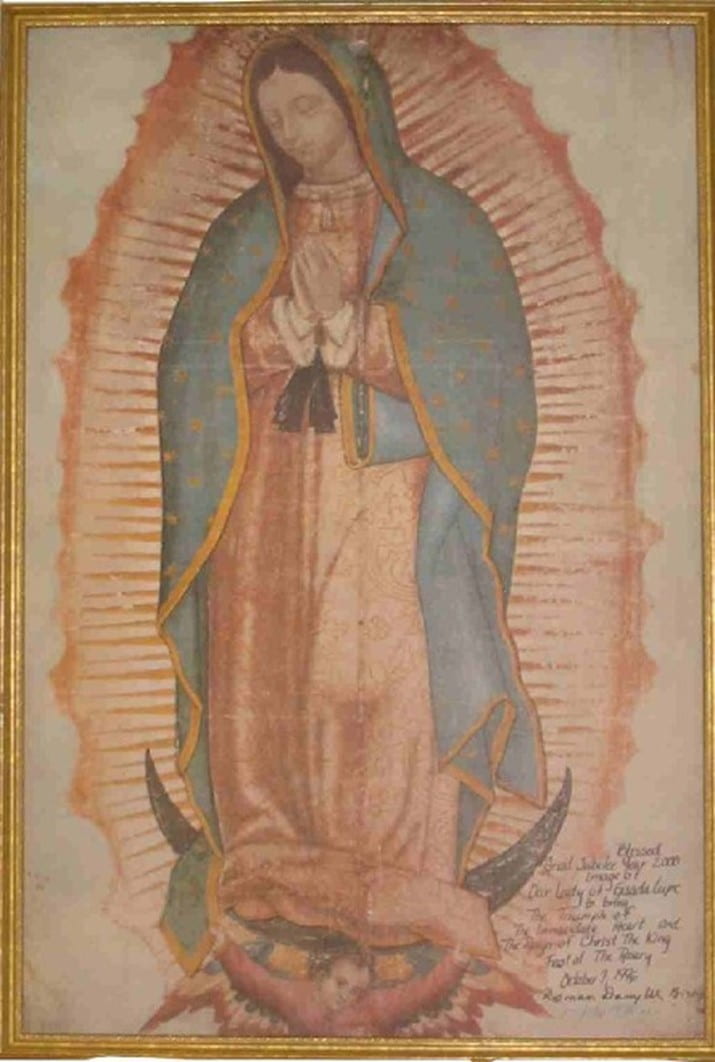This month, September 15th to October 15th, is National Hispanic and Latino Heritage Month and the University of Arkansas Museum is celebrating with a series of blogs and social media posts by Latino and Latin American Studies major Emily Snyder about her experiences with Latinx culture. In this blog post, she explains her connection to Latinx culture: how it began and how it developed into a desire to study Latino and Latin American studies.
Our Lady of Guadalupe, said to have appeared to Juan Diego in Mexico in 1531, is an enigmatic figure of great religious and cultural importance to many, and served as my introduction to Latinx culture when, as a young child raised in a predominantly Hispanic Catholic church, I saw the great religious devotion and cultural significance that she held. My family was very involved at the church, therefore I spent much of my childhood surrounded by the food, art, dance, and language of the Latinx community, developing a simultaneous sense of awe and comfort from the culture. In high school, I began learning to speak Spanish, and it allowed me to develop greater connection with the people in my community. In college, I began to study Latino and Latin American studies, and the increased knowledge of the culture that went beyond my own personal experiences created an even deeper level of appreciation.
In my sophomore year, I took an Anthropology course on religion in Latin America. It was fascinating to delve into religions from the region beyond my scope of understanding, like Santeria, as well as the ways in which indigenous religious beliefs had affected Catholicism that I either could recognize as having influenced the way I was taught about religion or even which I found a greater personal connection to. One topic we examined in that class that was particularly resonant to me was Our Lady of Guadalupe. The image to the right is famous for being the image that appeared on the tilma of Juan Diego after he collected roses in his cloak from the site where Our Lady appeared to him to tell him to build a church.

Image of Our Lady of Guadalupe from Juan Diego’s Tilma. Picture from https://olg.cc/about/about-our-patroness/our-ladys-image-on-the-tilma/
Since then, Our Lady has taken on many different meanings to different people and has been depicted in many forms that we discussed in class. Chicana artist Yolanda López is known for her depictions of Our Lady as Chicana women, specifically herself, her mother, and her grandmother. She takes the traditional picture of Our Lady, which is steeped in the influences of colonialism and patriarchy that the image originated in, and transforms it to express the experiences of different Chicana women beyond the expectations of society for them. In Portrait of the Artist as the Virgin of Guadalupe (1978), Lopez paints herself as a free and triumphant version of Our Lady demonstrating the agency and joy she sees in Chicana women. In Margaret F. Stewart: Our Lady of Guadalupe (1978), she paints her mother as a version of Our Lady who is sewing her own garment, showing the beauty in all the tasks that Chicana women partake in, even the ones considered menial by society.
Viewing this art and discussing all of the messages it contained in my Anthropology class opened new doors for me in how I related to and understood Our Lady of Guadalupe, a figure that had held significance to me up to that point, but which was enriched by this new perspective of an incredible Chicana artist that I was exposed to through my continued exploration into Latino culture.
As I’ve learned more, Latinx culture has remained as a source of awe and comfort that allows me to appreciate the wider world and understand others and myself better. Throughout National Hispanic and Latino Heritage Month, I will continue to share additional information and resources about Latinx culture to hopefully share this awe and comfort with others and inspire new passions. I invite you to visit the links in this blog, as well as the National Hispanic Heritage Month website, and follow along this month on the museum’s social media to delve deeper into the rich history, art, and culture of the Latinx and Hispanic communities.
Contributor: Emily Snyder is a senior Honors College Fellow majoring in History and Latin American and Latino Studies and minoring in Spanish and Anthropology. Emily is involved on campus as President of the University of Arkansas Museum Student Advisory Council, an Honors College Ambassador, and a member of Phi Alpha Theta. After college, Emily plans to pursue a graduate degree in museum and archival studies.